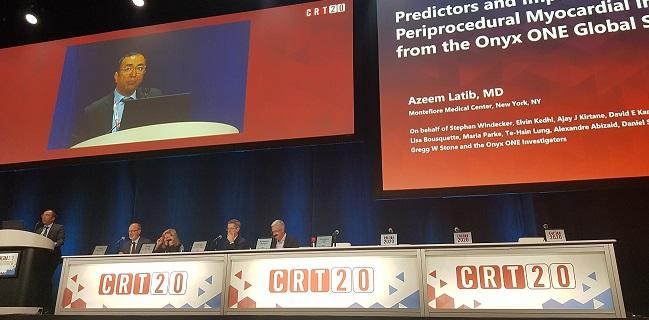PCI-Related MIs Not Linked to Mortality at 1 Year: Onyx ONE
The high rate of MI in the study worried some physicians, but investigators say the events have no impact on prognosis.

NATIONAL HARBOR, MD—Patients at high risk for bleeding who experience a myocardial infarction during stent implantation with either the durable-polymer Resolute Onyx zotarolimus-eluting stent (Medtronic) or the polymer-free, drug-coated BioFreedom stent (Biosensors) are not at a higher risk of death at 1 year when compared with patients without documented periprocedural MIs.
Those are the main conclusions from a new post hoc analysis of the Onyx ONE study, presented this week at CRT 2020. The results should reassure physicians that the high rate of periprocedural MI in the trial had no detrimental effect on long-term prognosis, say investigators.
Azeem Latib, MD (Montefiore Medical Center, New York, NY), who presented the new analysis during a late-breaking clinical trials session, said the high rate of periprocedural MI in Onyx ONE might have been the result of ascertainment bias, noting that patients in the trial were meticulously tracked. “However, looking at the data for periprocedural and spontaneous MI, only spontaneous MI appeared to have an impact on mortality and was identified as an independent predictor in this study,” he said.
Definitions of periprocedural MI are a hot topic these days, said Sunil Rao, MD (Duke Clinical Research Institute, Durham, NC), one of the session moderators. The EXCEL investigators have been involved in a contentious back-and-forth with critics for not publishing MI event rates based on the universal definition, which uses rises in cardiac troponin (cTn) to define criteria for procedural MI. By contrast, the NOBLE trial, also comparing PCI and CABG for left main disease, excluded periprocedural MIs from the endpoint definitions and showed a clear advantage for CABG in this setting. However, given advances in the development of sensitive markers of myocardial injury, Rao questioned if it was even possible to reach a consensus on the “best” definition of MI.
For his part, Latib said it’s a very topical question given the EXCEL controversy and added that what’s done in clinical trials differs from routine clinical practice. “Certainly, at my center, we don’t routinely measure enzymes anymore because we really don’t believe that measuring troponin increases of five times [the upper limit of normal] is clinically significant for patients,” said Latib. “The patients who have a clinically important MI, you usually know about them because they have ECG changes or chest pain.”
Cindy Grines, MD (Northwell Health, Manhasset, New York), said that line of thinking is validated by the data in Onyx ONE, where periprocedural MIs had no influence on mortality at 1 year. James Hermiller, MD (St. Vincent Heart Center, Indianapolis, IN), agreed.
“When you define periprocedural MI by the very strict definition used in the study, we know that those are not prognostically significant,” Hermiller told TCTMD. “To me, the MI rates got a lot of press at the time, but it’s how you define a periprocedural event . . . . The spontaneous MI, that has very important implications, and some of periprocedural MIs do as well, but it needs to a big enzymatic infarct.”
From a research perspective, Latib there is a need for a consistent definition of periprocedural MI to facilitate comparisons across different studies, as well as a better consensus regarding what constitutes a clinically relevant periprocedural MI. “Every study I see uses a different definition, and when we report one definition, and not the other one, as in EXCEL, we’re accused of trying to hide data,” he said. “I think we need to report what’s clinically important for patients.”
Onyx ONE and ISCHEMIA
In Onyx ONE, a study which included 2,000 patients at high risk for bleeding who underwent PCI and received just 1 month of dual antiplatelet therapy, the rates of MI were high by the standards of historical DES trials. At 1 year, the rates of MI with Resolute Onyx and BioFreedom were 13.4% and 14.7%, respectively, and this was driven by the high rate of periprocedural MI. The rates of periprocedural MI, which were defined using the third universal definition, were 9.4% and 7.9%, respectively.
As part of the post hoc analysis, the researchers assessed the rate of periprocedural MIs using different definitions. MIs adjudicated using the universal definition require cTn levels > 5x the upper limit of normal (ULN) and at least one clinical criterion for PCI-related MI, such as symptoms or new ECG changes or Q-waves. The Society for Cardiovascular Angiography and Interventions (SCAI) definition, which is meant to capture clinically relevant MIs, also tracks cTn levels, but only considers events where cTn levels exceed 70x ULN (or > 35x ULN in the presence of new Q-waves). Similarly, the Academic Research Consortium (ARC)-2 definition includes patients with cTn > 70x ULN (or cTn > 35x ULN with any new significant Q-waves, flow-limiting angiographic complications, or new substantial loss of myocardium on imaging).
The rates of periprocedural MI with Resolute Onyx and BioFreedom were 3.7% and 3.2%, respectively, when investigators only counted events captured by the SCAI/ARC-2 definitions (cTn > 70x ULN). In total, 39% of the total periprocedural MIs in Onyx ONE met this stricter threshold for periprocedural MI.
“We also looked at the clinical evidence of ischemia,” said Latib. “For the majority of patients, more than 70%, the only other evidence was angiographic evidence of a side-branch occlusion identified by the operator and confirmed by the [clinical endpoint committee]. Only a small percentage of patients had symptoms as well as the troponin rises and only 2.9% had ECG changes.”
Regarding the prognostic implications of the infarcts, the rate of all-cause mortality at 1 year was 9.6% for all patients with a periprocedural MI adjudicated using the universal definition, which wasn’t significantly higher than the rate of 7.5% observed in those without an MI. For patients who had a spontaneous MI during follow-up, the rate of all-cause mortality was 21.6% at 1 year. A spontaneous MI in the first year was associated with a more-than threefold higher risk of death (HR 3.30; 95% CI 1.92-5.74).
Latib said they did not assess the mortality rate using the different definitions of MI, or using various cTn thresholds, because the numbers of patients in each group would have been too small.
Why No Difference Between Stents?
The researchers also looked at patient characteristics as a means to potentially explain why patients in Onyx ONE experienced such a high rate of periprocedural MIs. Overall, those who had a PCI-related infarct were more likely to have diabetes, were more likely to have had a previous MI, and were more likely to have a lesion in the left anterior descending artery. Additionally, these patients presented with longer lesions compared with those who didn’t have a periprocedural event.
Alexandre Abizaid, MD (Instituto Dante Pazzanese de Cardiologia, São Paulo, Brazil), one of the moderators, said that while he could understand why patients had a higher rate of periprocedural MIs given their baseline and procedural characteristics, he was surprised that Resolute Onyx didn’t outperform the BioFreedom stent given that its struts are significantly thinner. “What’s the mechanism?” he asked. “Why didn’t the stent differentiate itself?”
Latib said there were some subtle differences between the two treatment arms, noting that patients who received the Resolute Onyx device had slightly longer lesions and received longer stents. “Also, there was significant crossover from the BioFreedom group to the Onyx group,” said Latib. “They crossed over because the operator could not deliver the BioFreedom stent and then switched to the Onyx device. That might have clouded why we don’t see a lower rate of periprocedural MI.”
At CRT 2020, several investigators also pointed to the ISCHEMIA trial, highlighting the fact that MI timing differed between treatment arms based on MI type, but the overall rate MI as defined in ISCHEMIA did not differ significantly between treatment arms.
Gregg Stone, MD (Icahn School of Medicine at Mount Sinai, New York, NY), who was tasked with critiquing ISCHEMIA at CRT 2020, pointed out that the rate of periprocedural MI in that trial was significantly higher in the intervention arm than in patients treated with optimal medical therapy (adjusted HR 2.98; 95% CI 1.87-4.74). On the other hand, the rate of late nonprocedural MIs—defined as types 1, 2, 4b, or 4c MIs—were significantly lower in the patients treated with PCI or CABG surgery (adjusted HR 0.67; 95% CI 0.53-0.83).
Stone said there is a planned analysis from ISCHEMIA on the prognostic impact of periprocedural MIs using multiple definitions that will be presented at the upcoming American College of Cardiology 2020 Scientific Session. There is little doubt concerning late, spontaneous MIs, he said, noting that nearly every study has shown these infarcts to be prognostically important, but less is known about periprocedural MIs, particularly those with smaller increases in cTn.
Michael O’Riordan is the Managing Editor for TCTMD. He completed his undergraduate degrees at Queen’s University in Kingston, ON, and…
Read Full BioSources
Latib A, on behalf of the Onyx ONE investigators. Predictors and implications of periprocedural myocardial infarction from the Onyx ONE global study. Presented at: CRT 2020. February 23, 2020. National Harbor, MD.
Disclosures
- Latib reports consulting for 4-Tech Cardio, Medtronic, Millipede, Mitralign, and Valtech Cardio and receiving research support and/or speaking fees from Abbott Vascular, Acist Medical, and Direct Flow Medical.
- Rao reports serving on an advisory board for Medtronic and Volcano.
- Grines reports no relevant conflicts of interest.
- Hermiller reports consulting for Abbott, Boston Scientific, Edwards Lifesciences, and Medtronic.


Comments